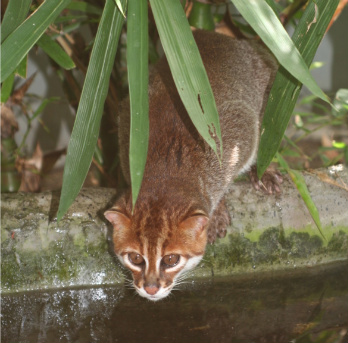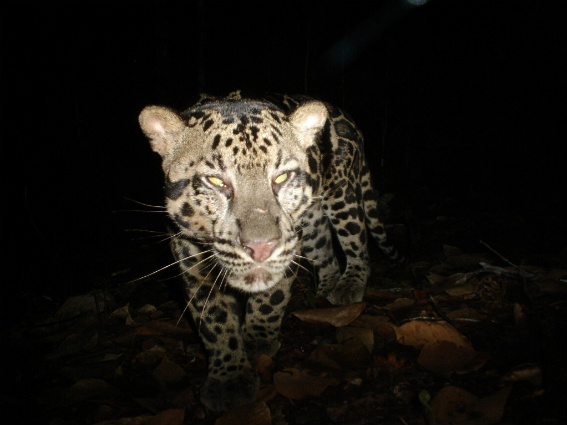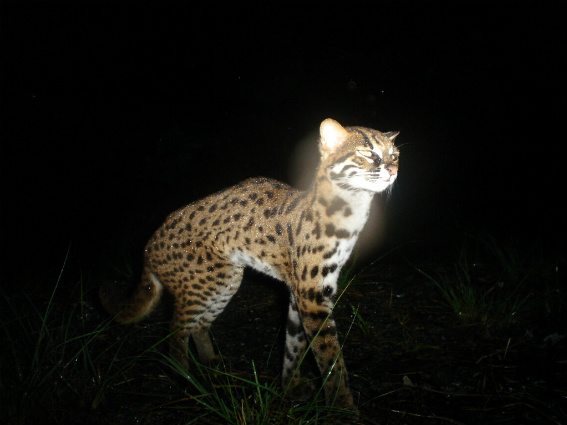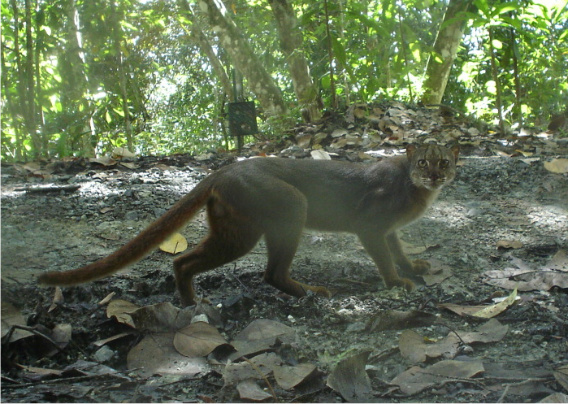Oil
palm expansion is threatening Borneo's rarest wild cats, reports a new
study based on three years of fieldwork and more than 17,000 camera trap
nights. Studying cats in five locations—each with different
environments—in Sabah, Malaysian Borneo, researchers found that four of
five cat species are threatened by habitat loss due to palm oil
plantations.
"No other place has a higher percentage of threatened wild cats!" Jim Sanderson, an expert on the world's small cats, told Mongabay.com. Pointing out that 80 percent of Borneo's cats face extinction, Sanderson said that "not one of these wild cats poses a direct threat to humans."
The groundbreaking study, undertaken by Jo Ross and Andrew Hearn with the UK's Global Canopy Program's Bornean Wild Cat and Clouded Leopard Project, has uncovered some of the first data on Borneo's wild cats. The five cats species in Borneo include the Sunda clouded leopard, the bay cat, the marbled cat, the leopard cat, and the flat-headed cat (camera trap photos below).
"No other place has a higher percentage of threatened wild cats!" Jim Sanderson, an expert on the world's small cats, told Mongabay.com. Pointing out that 80 percent of Borneo's cats face extinction, Sanderson said that "not one of these wild cats poses a direct threat to humans."
The groundbreaking study, undertaken by Jo Ross and Andrew Hearn with the UK's Global Canopy Program's Bornean Wild Cat and Clouded Leopard Project, has uncovered some of the first data on Borneo's wild cats. The five cats species in Borneo include the Sunda clouded leopard, the bay cat, the marbled cat, the leopard cat, and the flat-headed cat (camera trap photos below).
 A flat-headed cat in captivity. Very little is known about this species, though it is heavily adapted to catching freshwater species and likely spends a lot of time hunting in water. Photo by: Jim Sanderson. |
Ross and Hearn discovered that Borneo's cats were present in both primary forests and recently logged over forest, yet only one of the five cat species—the leopard cat—utilizes palm oil plantations. For the other four species, palm oil plantations appear to be off-limits, even for migration purposes. In addition, Ross and Hearn found no evidence of the flat-headed cat utilizing or migrating in palm oil plantations, despite claims that the cats survive there. The researchers say that their findings should give special emphasis to keeping remaining forests—even those recently logged—free from further palm oil expansion.
The researchers also succeeded in estimating population densities for the Sunda clouded leopard using camera traps, as well as radio collaring and tracking an individual clouded leopard. The Sunda clouded leopard, which is endemic to Borneo and Sumatra, has only recently been declared a distinct species from the mainland clouded leopard.
Ross and Hearn have also taken the first photographs of the elusive bay cat in Sabah, and have recorded the world's only video of the cat.
Three of Borneo's five cats are classified as Endangered by the IUCN: the Sunda clouded leopard, the bay cat, and the flat-headed cat.
"Wild cat (and wildlife) endangerment is due to a wide variety of threats including: unmitigated massive habitat loss caused by palm oil plantations, unregulated destructive logging practices including widespread small-scale illegal logging, unchecked poaching even in conservation areas and wildlife reserves, destruction of fresh water rivers and streams from logging, dumping of debris from oil palm plantations, bottom dredging for gold, and pollution caused by the use of streams as sewers, and the widespread use of nets for fishing," Sanderson explains.
Except for the leopard cat, Borneo's cats all occur in low densities. The study found that to have a viable population of 250 Sunda clouded leopards requires an area of 3,000-8,600 square kilometers (1,158-3,088 square miles). There are very places in Sabah with this much forest left.
"These wild cats, and especially the Sunda clouded leopard are important emblems of Borneo’s forests, and it is vital to conserve them as umbrella species which provide protection to forest wildlife in general," Macdonald said.
The marbled cat is classified as Vulnerable by the IUCN Red List. The leopard cat is the only one not considered threatened and is classified as Least Concern.
The workshop entitled "First Steps Towards Conserving Bornean Wild Cats" is hosted by the Sabah Wildlife Department in collaboration with Universiti Malaysia Sabah and Global Canopy Program's Bornean Wild Cat and Clouded Leopard Project. The project is largely funded by the UK government's Darwin Initiative.

Sunda
clouded leopard caught in a camera trap. In Borneo the Sunda clouded
leopard is the largest cat species, but in Sumatra it competes with the
Sumatran tiger. Copyright: Global Canopy Programme. Photo by: Jo Ross
and Andrew Hearn.


The
leopard cat in Borneo is considered a unique subspecies. Copyright:
Global Canopy Programme. Photo by: Jo Ross and Andrew Hearn.


Researchers
suspect there are less than 2,500 mature bay cats left in the wild. The
species is endemic to Borneo and rampant deforestation is the main
threat. Copyright: Global Canopy Programme. Photo by: Jo Ross and Andrew
Hearn.


The
marbled cat: this species has never been fully studied. Very little is
known of its ecology. Copyright: Global Canopy Programme. Photo by: Jo
Ross and Andrew Hearn.
Read more: http://news.mongabay.com/2009/1104-hance_borneo_cats.html#ixzz1vZow7rkB






4 comments:
Oil palm plantation activities should be monitored so as not to threaten the habitat of wild animals.
Hopefully the Oil Palm Plantation will be done more responsibly so not to affect the Wild Cat's natural habitat. Better control in opening up new lands for the oil palm industry is definitely needed.
Maybe the Sabah Wildlife Department can help protect these wild cat species from becoming endangered by relocating them to the few forest reserves and wildlife sanctuary in the state.
kalau jalan2 di ladang kelapa sawit, masih boleh jumpa juga haiwan ni..
Post a Comment